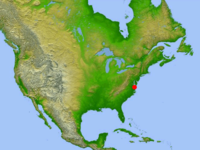
Photo from wikipedia
In the outback of Western Australia, researchers have shown that shocked rocks were forged 2.229 billion years ago, when an asteroid crashed into our planet. The finding makes Yarrabubba crater,… Click to show full abstract
In the outback of Western Australia, researchers have shown that shocked rocks were forged 2.229 billion years ago, when an asteroid crashed into our planet. The finding makes Yarrabubba crater, the 70-kilometer-wide scar left by the collision, Earth9s oldest. The geologists who reported the date last week, at the Goldschmidt geochemistry conference, also point out a conspicuous coincidence: The impact came at the tail end of a planetwide deep freeze known as Snowball Earth. They say the impact may have helped thaw Earth by vaporizing thick ice sheets and lofting steam into the stratosphere, creating a powerful greenhouse effect. Other researchers are skeptical that Yarrabubba—which is just one-third the size of the crater left by the dinosaur-killing impact 66 million years ago—could have had such a profound effect on the climate. Still, they say, paleoclimate studies should consider the possible role of such violent collisions.
Journal Title: Science
Year Published: 2019
Link to full text (if available)
Share on Social Media: Sign Up to like & get
recommendations!